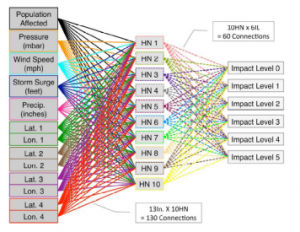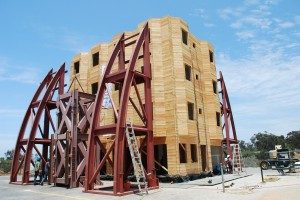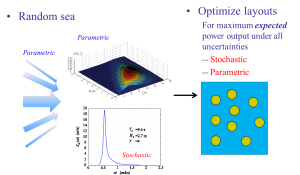Risk-Informed Decision Support
Natural Hazard Modeling
Natural hazards threaten the safety and resilience of our civil infrastructure ranging from public lifelines to private houses and buildings every day. The risk, although cannot be eliminated, can be understood and minimized through accurate modeling and simulation of the hazards and their impacts on infrastructure. Our faculty focuses on advancing the modeling and simulation tools of various natural hazards such as hurricanes, tornados, earthquakes, wildfire etc. These tools provide inputs to subsequent resilience analysis and risk-informed decision making regarding the impact of natural hazards on infrastructure.
Real-time risk assessment and decision
- Topic: Quantifying risk of natural disasters real time

Model neural network general structure for Hurricane Impact assessment (Pilkington and Mahmoud 2017)The importance of quantifying risk of natural disasters real time is critical for emergency managers in understanding the impact of the hazard and in communicating risk to the public. In doing so, effective evacuation orders can be issued and post-disaster recovery efforts can be orchestrates. It is therefore prudent that accurate and computationally efficient models can be used for rapid assessment of the impact of the hazard and the evolution as well as variation of such over time. Tropical cyclones are an example of an event with impacts that can highly vary depending on landfall location, wind speed, storm surge, and inland flooding from precipitation. These storms are typically categorized by their wind speed and pressure, while evacuation orders are typically given based on storm surge. The general public relies on these single hazard assessment parameters when attempting to understand the risk of an oncoming event. However, after the fact, these events are ranked by economic damage and death toll. Therefore, it is imperative that when these events are communicated to the public, during the forecast period, the multiple hazards are incorporated in terms the public can easily associate with, such as economic damage. At Colorado State University, ongoing work is being conducted to evaluate the real-time use of artificial neural networks (ANN) to forecast a range of economic damage from tropical cyclone events. The developed ANN model has been successfully used for forecasting the 2016, 2017, and 2018 United States hurricane season. The model was built prior to the start of each season and simulated every 3 hours, in conjunction with National Hurricane Center (NHC) issued advisories, for oncoming tropical cyclones forecasted to make landfall. Weaker and more common tropical cyclones have a less varied forecast and produce more accurate impact level (IL) predictions. Relevant studies can be found in the reference list below:
- Pilkington, S. and Mahmoud (2017) “Real-Time Application of the Multi-Hazard Hurricane Impact Level Model for the Atlantic Basin”, Frontiers in Built Environment – Wind Engineering and Science – Tropical Cyclone Damage Mitigation and Risk Modeling; https://www.frontiersin.org/articles/10.3389/fbuil.2017.00067/full, DOI: 10.3389/fbuil.2017.00067, Vol. 3(67).
- Pilkington, S. and Mahmoud, H. (2016) “Using Artificial Neural Networks to Forecast Economic Impact of Multi-Hazard Hurricane-Based Events”, Sustainable and Resilient Infrastructure, Vol. 1, issue (1-2).
- Topic: Real-time natural hazard risk assessment utilizing soft computing techniques
Description of topic: Accurate and timely assessment of the potential risks caused by natural hazards is critical for effective risk mitigation. This research topic focuses on developing a generalized framework for real-time hurricane, tsunami, and flooding risk assessment for coastal regions. Various challenges need to be resolved such as addressing the time variation of the responses or extending the approach to loss estimation for infrastructure systems. Also, relevant data collected in real events either through sensor networks or the public/crowdsourcing can also be explored through soft computing and data mining techniques to help establish predictive models and to facilitate further risk assessment. In the end, real-time risk assessment tools will be developed to enable emergency response manager for risk mitigation planning and decision making.
http://www.engr.colostate.edu/~gjia/research.shtml
Optimization of systems and their design
Engineering systems span a vast array of size, complexity, and application and range in size from low-rise wood structures in coastal regions to power transmission lines that span vast regions of uninhabited mountains or planes. Designing these systems based on inherent levels of risk can involve dozens of variables that include system geometry, materials, and the environment.
Our faculty use principles of structural mechanics, engineering design, probabilistic methods, and environmental impact to study and implement design procedures for civil engineering systems. Consideration of the trade-offs inherent in any design allows for the implementation of novel new material systems or structural components that can drastically improve performance while maintaining levels of safety and lifespan.

NEES Soft Building during shake table testing.

Transmission line galloping during blowing ice, leading to large forces at supporting structures.
Example:
- Topic: Layout optimization of wave energy converters in a random sea

http://www.engr.colostate.edu/~gjia/research.shtml
Transportation management systems
Critical infrastructure systems in modern communities that are essential to the economic security and social well-being are susceptible to damage due to extreme natural hazards. The aftermath of several major hurricanes, such as Katrina, Sandy and Maria revealed the importance of disaster mitigation strategies that focus on the resilience of the community as a whole, rather than those that simply address safety and functionality of individual infrastructure facilities. Among all critical infrastructures, several are highly interdependent, such as electricity, transportation, water and communications. During the whole process of community recovery, transportation plays a key role to prepare for, response to and recovery from any major hazardous events, including supporting other disrupted infrastructure systems. Resilient transportation management systems based on reliable information of associated risks for specific scenarios therefore become pivotal to supporting the prevention, response and recovery efforts of other infrastructures and the whole community. Some ongoing efforts related to this theme include:
- Risk-informed long-span bridge management system in windy environment;
- Innovative traffic routing advising system under adverse driving environment based on both traffic safety and efficiency criteria;
- Reliability-based emergency medical service vehicle dispatch, routing and management system.
Structural health monitoring
Through in-situ observations of structural systems, full-scale structural health monitoring (SHM) serves as a unique means to validate design practices, assess the condition/performance of structures, as well as provide feedback information for operations and management of civil infrastructure. Various sensing technologies (e.g. wireless sensor network, accelerometers, GPS, vision cameras etc.) have been developed for SHM systems to measure system response/performance under both operational environments and extreme events in past two decades. Recently, unmanned aerial vehicle (UAV)-based remote sensing has emerged as a new promising sensing technology to observe the performance of the as-built structures. To provide useful knowledge that supports risk-informed decision making in maintenance/operation of infrastructure, raw data collected by these monitoring systems need to be analyzed and interpreted. Our studies center on the development of automatic and real-time data analysis tools that permit seamless translation from data to knowledge, with the special focus on new types of sensing data, such as UAV collected data.
http://www.engr.colostate.edu/~yanlin/index.shtml
Integrating physical, social, and economic systems
Events such as Hurricane Katrina in 2005, the 2011 Christchurch, New Zealand earthquake, the 2011 Great Tohoku, Japan earthquake and tsunami, Superstorm Sandy (2012), and other events worldwide have highlighted the need to better understand and model community resilience, including interdependencies among physical infrastructure components and systems that may exacerbate their lack of functionality following a damaging hazard event and delay community recovery and the dependence of supporting social and economic institutions on that physical infrastructure. In 2015, the National Institute of Standards and Technology (NIST) funded the multi-university five-year Center of Excellence for Risk-Based Community Resilience Planning (CoE), headquartered at Colorado State University. The Center’s purpose is to develop the measurement science needed to understand what makes communities resilient and to develop a computational environment with fully integrated supporting databases that will enable resilience enhancement/planning and recovery strategies to be optimized. The approaches within the CoE couple engineering, sociology, and economics to support engineering and policy decisions by informing stakeholders and decision-makers of potential the choices and consequences. Several projects at CSU including the CoE have focused on risk-informed decision.
NIST Center of Excellence:
http://resilience.colostate.edu
A Risk-Informed Decision Framework to Achieve Resilient and Sustainable Buildings that Meet Community Objectives:
http://rsb.colostate.edu
Scalable Decision Model to Achieve Local and Regional Resilience of Interdependent Critical Infrastructure Systems and Communities:
https://www.nsf.gov/awardsearch/showAward?AWD_ID=1638284&HistoricalAwards=false
(John van de Lindt, Bruce Ellingwood, Suren Chen, Gaofeng Jia, Yanlin Guo, Hussam Mahmoud)